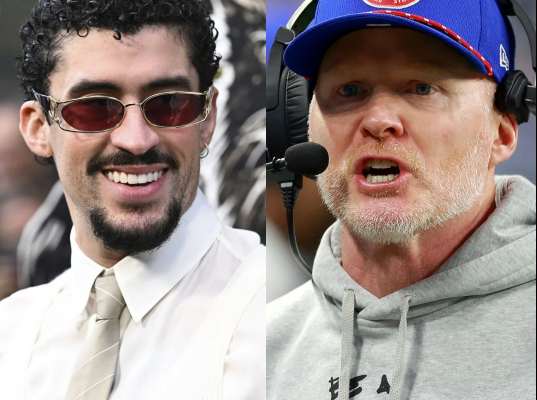
The claim that Buffalo Bills head coach Sean McDermott has publicly criticized the National Football League for its choice of Bad Bunny as the Super Bowl halftime performer and allegedly threatened to pull his team from the game has swept through social media with the force of a breaking scandal. It is framed in a dramatic fashion, presented as if the NFL has suddenly been plunged into crisis by one coach’s defiance. Yet the deeper one looks, the clearer it becomes that the story lacks the foundation of credible evidence. What remains is a useful case study in how misinformation grows in the fertile ground of cultural and political polarization.
To begin with, let us review the facts that are beyond dispute. Bad Bunny, the Puerto Rican superstar who has become one of the most streamed artists in the world, has indeed been announced as the official headliner for the 2026 Super Bowl halftime show. The NFL, working with Apple Music and Roc Nation, confirmed this in late September. The game will take place at Levi’s Stadium in Santa Clara, California. Bad Bunny has described the honor as a tribute to his culture and language, promising to deliver a performance that reflects both his heritage and his global audience. This announcement alone made headlines across mainstream media and generated both excitement and criticism.
On the side of enthusiasm, millions of fans celebrated the recognition of Latin music and culture on such a massive stage. Bad Bunny has consistently broken barriers in the music industry, and his presence at the Super Bowl is a natural extension of his status. On the side of criticism, however, a chorus of voices emerged, largely from conservative political figures and media commentators. Some objected to the idea of a Spanish-speaking performer in America’s most watched sporting event. Others linked the choice to broader cultural battles, portraying it as a sign that the NFL is more interested in politics and social statements than in football tradition. Still others raised practical complaints about whether his music appeals to the league’s core demographic.
It is within this context that the alleged McDermott quote surfaces. Posts circulating online claim that the Bills’ coach declared, “Is this football or a circus?” and threatened to pull his team from the game if the performance remains on the schedule. The supposed quote has been shared in Facebook posts and meme pages styled with words like “breaking,” “shocking,” and “NFL in chaos.” The language is clearly designed to provoke outrage and clicks. Yet not a single credible sports journalism outlet, news network, or official NFL communication corroborates it. There is no video of McDermott making such remarks, no press conference transcript, no reporting from established reporters who cover the Bills or the league.
The absence of mainstream coverage is itself evidence against the claim. If a head coach of an NFL team truly threatened to withdraw from the Super Bowl over an entertainment choice, it would be unprecedented in league history. The financial, legal, and competitive stakes are immense. The NFL would face enormous liability, the team would be subject to disciplinary measures, and the coach himself would risk his career. Such a statement would instantly dominate headlines in ESPN, Sports Illustrated, NFL Network, and beyond. Instead, the only mentions appear in low-credibility corners of social media.
So why do stories like this emerge and gain traction? The answer lies partly in the environment of cultural polarization. The halftime show has become a symbolic battleground where issues of identity, representation, and politics are played out under the guise of entertainment. From Janet Jackson’s controversial performance in 2004, to Beyoncé’s politically charged 2016 appearance, to Jennifer Lopez and Shakira in 2020, nearly every high-profile halftime act has sparked debate. In this climate, it is easy to imagine a conservative-leaning coach rejecting what he sees as a spectacle. The plausibility makes the falsehood easier to spread.
Moreover, attaching the story to Sean McDermott specifically lends it credibility. McDermott is a respected and visible figure in the league, having led the Bills to multiple playoff appearances and built a strong organizational culture. By attributing a rebellious comment to him, the rumor carries weight that it would not if linked to an anonymous source. For critics of the NFL’s decision, the alleged statement validates their own frustration, making them more likely to share it without question.
The structure of the rumor also reveals how misinformation functions online. It uses dramatic framing: “breaking,” “publicly criticizes,” “threatens to pull team.” These words are chosen not to report facts but to trigger emotion. Outrage and shock are powerful motivators for engagement. Once shared, the repetition across different platforms gives an illusion of authenticity, even though the core claim has no evidentiary basis.
The situation highlights an important point about plausibility versus verification. While it is not impossible that a coach somewhere might complain about halftime entertainment, it is highly implausible that any coach would risk his job by making such a public threat. Even if a coach privately disliked the choice of Bad Bunny, the NFL’s structure ensures that entertainment decisions are far beyond the authority of any team or coach. The idea that a head coach could force the NFL to cancel or alter the halftime show misunderstands the power dynamics of the league.
It is also instructive to look at the broader landscape of real, verifiable criticism of Bad Bunny’s selection. Figures such as Texas Attorney General Ken Paxton and various conservative commentators have openly questioned the NFL’s decision. NewsMax hosts have complained about the use of Spanish lyrics on such a stage. A Trump adviser has even floated the provocative suggestion that immigration enforcement agents might appear at the Super Bowl, framing the artist’s participation as a political provocation. These statements, though controversial, are documented in mainstream reporting. The rumor about McDermott borrows energy from this real controversy but injects a false twist to intensify outrage.
For the informed reader, the lesson is clear. When confronted with sensational claims, especially those involving prominent figures and high-stakes institutions, the first step is to check for confirmation from reliable outlets. If the Associated Press, Reuters, ESPN, or NFL.com are silent, the odds are strong that the claim is either untrue or unverified. Next, consider plausibility: would the alleged action make sense in light of the individual’s role, incentives, and past behavior? Finally, trace the origin: if the claim surfaces only in meme pages or rumor accounts, it should be treated with skepticism.
The power of misinformation lies not in its accuracy but in its ability to hijack attention and amplify existing divisions. In this case, the idea that a coach would risk his team’s participation in the Super Bowl to protest a halftime artist is thrilling to those who already resent the NFL’s choice. It fits their worldview so neatly that they share it regardless of whether it is true. Meanwhile, those opposed to such criticism share it as evidence of conservative overreach, further fueling the cycle of outrage.
In reality, Sean McDermott has made no such statements, and the Buffalo Bills have not threatened to boycott the Super Bowl. The NFL remains committed to its decision, and Bad Bunny is preparing for what will likely be one of the most watched halftime shows in history. The controversy, while real in some political circles, has been exaggerated and distorted through false claims like this one. The truth is that the league continues to navigate cultural fault lines, balancing tradition, global influence, and commercial spectacle. The halftime stage is as much about cultural commentary as it is about entertainment, and Bad Bunny’s appearance is another chapter in that evolving story.
By stepping back, questioning sources, and distinguishing fact from rumor, readers can avoid being swept up in waves of misinformation. The McDermott story, while engaging, is almost certainly fiction. The real drama lies in how America continues to debate who gets to stand on its most prominent cultural stage, and what that choice says about the future of both football and national identity.

